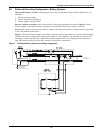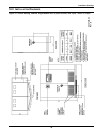
Wiring Connections
25
8.1 Specific Connections
Refer to the drawings in this manual and any other drawings provided by Liebert for this installation.
Make all of the following connections:
1. AC power cables from input power source circuit breaker (RIB) to UPS Module Input. Observe
phase rotation.
2. AC power cables from bypass power source circuit breaker (BIB) to UPS Module Bypass input.
Observe phase rotation.
3. AC power cables from UPS Module Output to critical load. Observe phase rotation.
4. For battery cabinets: DC power cables and ground from battery cabinet to UPS module and
between battery cabinets. Observe polarity. When multiple conduits are used, an equal number of
positive and negative cables should be contained in each conduit.
5. For remote battery: DC power cables (and ground) from battery to Module Battery Disconnect,
and then to UPS Module DC bus. Observe polarity. DC power cables should be installed in
conduit with conductors in matched pairs (positive and negative).
6. Module Battery Disconnect control wiring to UPS module (and between battery cabinets, if
applicable).
7. Control wiring to the optional Remote Monitor Panel, if used. Selected alarm messages are also
available for customer use through a set of contacts on an optional separate terminal board.
Wiring must be run in individual separate steel conduit.
8. Emergency Power Off control wiring must be run in separate steel conduit.
9. Communications wiring for optional site monitoring or modem must be run in separate steel
conduit.
10. Power and control connections required for the Maintenance Bypass.
11. Any additional special wiring required at your site.
NOTE
If your installation includes a Maintenance Bypass Panelboard or a Transformer Cabinet,
some or all power cables will be terminated in these cabinets. Make sure all required wiring
between the UPS module and the optional cabinets is completed per the submittal drawings.
Observe phase rotation.
!
CAUTION
If there are line-to-neutral loads connected to the UPS output, the bypass input source must
be wye connected and have three phases plus neutral plus ground. If the specified input is not
available, an isolation transformer is required. Refer to 6.1 - Preferred Grounding
Configuration, Wye-Connected Service, 6.3 - Preferred Grounding Configuration
With Isolated Bypass and 6.4 - Alternate Grounding Configuration, Non-Isolated.
See 6.0 - Configuring Your Neutral and Ground Connections for an explanation of
proper grounding techniques.
!
CAUTION
UPS bypass and output neutral must be connected to only one common point in the UPS. This
neutral line must be grounded at the source. See 6.0 - Configuring Your Neutral and
Ground Connections.
NOTE
DC power and battery circuit breaker control cables are provided with Liebert battery cabinets
for use between multiple cabinets when bolted together. Power cables are sized for
interconnecting battery cabinets. Battery cabinets specified for bolting up to the UPS are
shipped with power cables to connect the battery cabinet system to the UPS module. Field-
supplied cabling must be provided to connect stand-alone battery cabinets to the UPS module.
Connections from the final battery cabinet to the UPS are provided in the field.
!
WARNING
Do not make any connections between battery tiers in the battery cabinet. These connections
will be made by the Liebert Global Services representative during start-up.


















